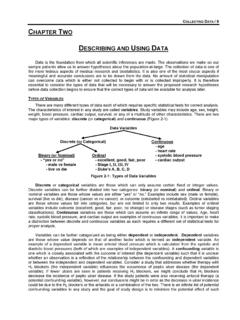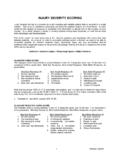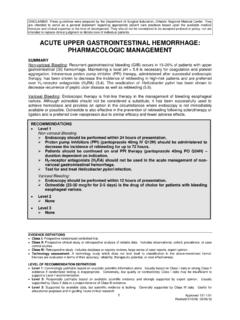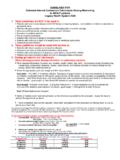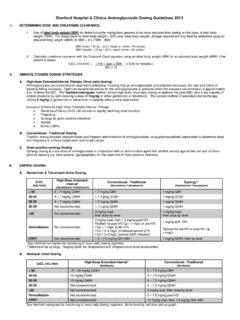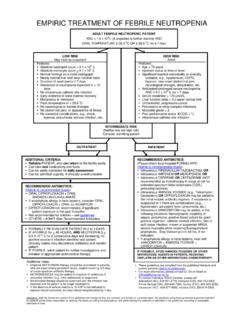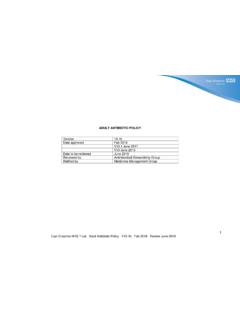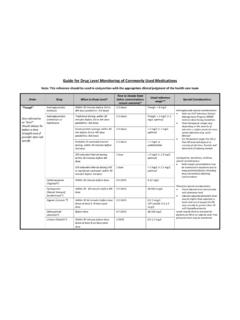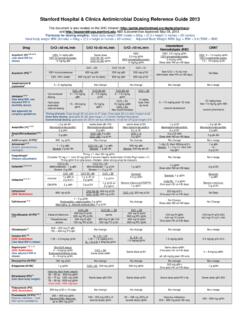Transcription of continuous antibiotic infusions - SurgicalCriticalCare.net
1 DISCLAIMER: These guidelines were prepared by the Department of Surgical Education, Orlando Regional Medical Center. They are intended to serve as a general statement regarding appropriate patient care practices based upon the available medical literature and clinical expertise at the time of development. They should not be considered to be accepted protocol or policy, nor are intended to replace clinical judgment or dictate care of individual patients. EVIDENCE DEFINITIONS Class I: Prospective randomized controlled trial. Class II: Prospective clinical study or retrospective analysis of reliable data. Includes observational, cohort, prevalence, or case control studies. Class III: Retrospective study. Includes database or registry reviews, large series of case reports, expert opinion. Technology assessment: A technology study which does not lend itself to classification in the above-mentioned format.
2 Devices are evaluated in terms of their accuracy, reliability, therapeutic potential, or cost effectiveness. LEVEL OF RECOMMENDATION DEFINITIONS Level 1: Convincingly justifiable based on available scientific information alone. Usually based on Class I data or strong Class II evidence if randomized testing is inappropriate. Conversely, low quality or contradictory Class I data may be insufficient to support a Level I recommendation. Level 2: Reasonably justifiable based on available scientific evidence and strongly supported by expert opinion. Usually supported by Class II data or a preponderance of Class III evidence. Level 3: Supported by available data, but scientific evidence is lacking. Generally supported by Class III data. Useful for educational purposes and in guiding future clinical research.
3 1 Approved 5/15/07 continuous antibiotic infusions SUMMARY It is well established that -lactam and glycopeptide antibiotics exhibit time dependent killing. The degree of antimicrobial killing correlates well with the amount of free drug remaining above the minimum inhibitory concentration (MIC) for a given amount of time over the dosing interval. continuous infusion is a method of administration that allows for consistent steady state concentrations and maximizes the percent of time above an organism s MIC. continuous infusion is an alternative to intermittent infusion . It does not demonstrate an economic, clinical, or microbiologic benefit to current standard of practice.
4 INTRODUCTION continuous infusion of antimicrobial agents has been studied since the 1950s. Penicillin was the first antibiotic studied using this method of administration. Investigators noted that it was most effective when serum concentrations at the site of infection remained above those that were necessary to kill the bacteria. In order to achieve maximal efficacy, penicillin had to be administered by continuous infusion or at 2-4 hour intervals. This early observation provided a basis for the concept of time-dependant killing. More recently, studies have provided evidence that the time-dependant activity of beta-lactam antibiotics is dependent on the percentage of time above the bacteria s MIC and correlates well with therapeutic efficacy (1). Greater killing is not achieved with beta-lactam antibiotics once the MIC is exceeded by 4-5 times.
5 The results of clinical trials have established the minimum percent time above the MIC for many beta-lactam agents. Optimal efficacy of penicillins, cephalosporins, and carbapenems is achieved when serum concentrations remain above the MIC for 50%, 50-60%, and 20-40% of the dosing interval, respectively (2-4). RECOMMENDATIONS Level 1 continuous infusion of piperacillin/tazobactam or vancomycin is a safe and effective alternative to intermittent infusion for the treatment of appropriate infections. Level 2 None Level 3 continuous infusion piperacillin/tazobactam should be considered for infections due to multi-drug resistant organisms when sensitivities to piperacillin/tazobactam are reported as Intermediate. There is insufficient evidence to support the use of meropenem or cefepime administered as a continuous infusion .
6 2 Approved 5/15/07 LITERATURE REVIEW Piperacillin/tazobactam Lau and colleagues conducted a non-inferiority study comparing the safety and efficacy of continuous versus intermittent infusion of piperacillin/tazobactam in patients with complicated intraabdominal infections. Those with severe renal dysfunction [creatinine clearance (CrCl) <20 mL/min], necrotizing pancreatitis, irreversible shock, and neutropenia were excluded. Two hundred sixty two patients from 33 sites were randomized. Duration of therapy ranged from 4-14 days. There were no differences between groups in the rate of clinical success at the test of cure visit 10-21 days after the last dose. continuous infusion was well tolerated and displayed a safety profile similar to that of intermittent infusion (5).
7 (Class I) Grant and colleagues performed a prospective, open-label study of continuous versus intermittent administration of piperacillin/tazobactam evaluating clinical, microbiologic, and economic outcomes. Patients with an absolute neutrophil count <1000 cells/mm3 and severe renal dysfunction (CrCl <20 mL/min) were excluded. Ninety-eight patients with clinical signs and symptoms consistent with infection were enrolled. There were no differences in clinical or microbiologic outcomes. However, the total amount of antibiotic administered per day was decreased by one-third and the mean cost for patients treated successfully with continuous infusion was statistically significant (p= ). No adverse events were directly associated with either regimen.
8 continuous infusion provided clinical and microbiological outcomes that resembled that of intermittent infusion but was more cost-effective (1). (Class II) Burgess and colleagues evaluated the pharmacokinetics and pharmacodynamics of piperacillin/tazobactam administered by continuous or intermittent infusion in a prospective, randomized, crossover study. Five clinical isolates each of Pseudomonas aeruginosa and Klebsiella pneumoniae were used for pharmacodynamic analyses. Patients with a history of drug or alcohol abuse, chronic disease, or a CrCl 80 mL/min were excluded. Eleven healthy volunteers were admitted on three separate occasions with a 7 day washout period. During each admission, patients were randomized to one of three dosing regimens.
9 The continuous infusion regimen consistently resulted in higher concentrations above the breakpoint for K. pneumoniae and many of the susceptible strains of P. aeruginosa than did the continuous infusion (6). (Class II) Vancomycin In a multicenter, prospective, randomized study, the administration of vancomycin by continuous or intermittent infusion in ICU patients with severe methicillin-resistant Staphylococcus aureus (MRSA) infections was compared in order to determine efficacy, safety, and cost-effectiveness. Patients with more than three organ failures, neutrophil cell count <1,000 cells/mm3, or a serum creatinine < mg/dL were excluded. One hundred nineteen patients with direct microbiologic examination showing gram-positive cocci were enrolled.
10 There was no significant difference between treatment failures at treatment end between groups. However, targeted trough concentrations were achieved faster (p= ), there was less variability between the groups with respect to AUC24 (p= ) and fewer samples per treatment were obtained in the continuous infusion group (p< ). Overall cost was 23% lower in the continuous infusion group. However, when the mean standard deviation of cost is taken into account, the results would suggest there is no difference between treatment groups. Nevertheless, continuous and intermittent infusions remain comparable in clinical efficacy and safety (7). (Class I) Meropenem Lorente and colleagues retrospectively evaluated the clinical efficacy of continuous versus intermittent infusion of meropenem for the treatment of ventilator-associated pneumonia (VAP) due to gram-negative bacilli.



